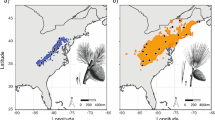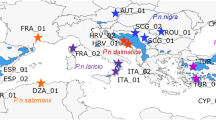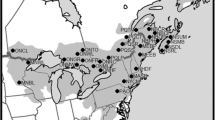Abstract
Context
Mediterranean pines share many common life-history traits. They are found at almost all altitudinal levels around the Mediterranean Basin, from sea level to high-elevation mountains, and from hot and dry to wet and cold bioclimates. Their distribution ranges from widespread to regional and narrow, and from dense extensive populations to small populations of scattered individuals. They have been extensively used by human civilizations for millennia.
Aims
I show which are the main phylogenetic, ecological, and climatic factors explaining the patterns of within and among-population genetic diversity in Mediterranean pines.
Methods
I use a narrative synthesis approach and multiple examples from the literature on pine species from the Mediterranean Basin and California.
Results
While Mediterranean pines have the highest levels of differentiation worldwide, their genetic diversity increases from west to east and is significantly reduced in low-elevation species. Factors such as ancestral adaptation to wildfire, reduction of effective population size during the Last Glacial Maximum, long distance dispersal during the Holocene, and more recent adaptation to patchy environmental conditions could explain these patterns.
Conclusion
Because of contrasted ecological, demographic, historical, and geographical processes, and despite their common biological attributes, pines of the Mediterranean Basin display complex biogeographic patterns at neutral gene level that can help retrace their evolutionary history. Although individual species often represent unique case studies that make generalizations risky, locating habitats of significantly high and low genetic diversity is key for detecting and understanding the major factors affecting gene diversity and may prove useful for profiling areas of high conservation value in the Mediterranean.

Similar content being viewed by others
References
Alía R., Martín S (2003) EUFORGEN Technical Guidelines for genetic conservation and use for Maritime pine (Pinus pinaster). International Plant Genetic Resources Institute, Rome, Italy
Austerlitz F, Mariette S, Machon N, Gouyon P-H, Godelle B (2000) Effects of colonization processes on genetic diversity: differences between annual plants and tree species. Genetics 154:1309–1321
Barbéro M, Loisel R, Quézel P, Richardson DM, Romane F (1998) Pines of the Mediterranean Basin. In: Richardson DM (ed) Ecology and biogeography of Pinus. Cambridge Univ. Press, Cambridge
Benito-Garzón M, de Dios RS, Ollero HS (2007) Predictive modelling of tree species distributions on the Iberian Peninsula during the Last Glacial Maximum and Mid-Holocene. Ecography 30:120–134
Benito-Garzón M, Alia R, Robson TR, Zavala MA (2011) Intra-specific variability and plasticity influence potential tree species. Glob Ecol Biogeogr 20:766–778
Bucci G, Gonzalez-Martinez SC, Le Provost G, Plomion C, Ribeiro MM, Sebastiani F, Alia R, Vendramin GG (2007) Range-wide phylogeography and gene zones in Pinus pinaster Ait. revealed by chloroplast microsatellite markers. Mol Ecol 16:2137–2153
Chambel MR, Climent J, Alía R (2007) Divergence among species and populations of Mediterranean pines in biomass allocation of seedlings grown under two watering regimes. Ann For Sci 64:87–97
Climent J, Costa e Silva F, Chambel MR, Pardos M, Almeida MH (2009) Freezing injury in primary and secondary needles of Mediterranean pine species of contrasting ecological niches. Annals of Forest Science, 66, article 407
Eckert AJ, Hall BD (2006) Phylogeny, historical biogeography, and patterns of diversification for Pinus (Pinaceae): phylogenetic tests of fossil-based hypotheses. Mol Phylogenet Evol 40:166–182
Eveno E, Collada C, Guevara MA, Léger V, Soto A, Díaz L, Léger P et al (2008) Contrasting patterns of selection at Pinus pinaster Ait. drought stress candidate genes as revealed by genetic differentiation analyses. Mol Biol Evol 25:417–437
Fady B (2005) Is there really more biodiversity in Mediterranean forest ecosystems? Taxon 54:905–910
Fady B, Conord C (2010) Macroecological patterns of species and genetic diversity in vascular plants of the Mediterranean Basin. Divers Distrib 16:53–64
Fady B, Médail F (2004) Mediterranean forest ecosystems. In: Burley J, Evans J, Youngquist JA (eds) Encyclopedia of forest science. Elsevier, London, pp 1403–1414
Fady B, Semerci H, Vendramin GG (2003) Technical guidelines for genetic conservation and use for Aleppo pine (Pinus halepensis) and Brutia pine (Pinus brutia). EUFORGEN. International Plant Genetic Resources Institute, Rome, 6p
Fady B, Fineschi S, Vendramin GG (2004) EUFORGEN technical guidelines for genetic conservation and use for Italian stone pine (Pinus pinea). International Plant Genetic Resources Institute, Rome
Fallour D, Fady B, Lefèvre F (1997) Study on isozyme variation in Pinus pinea L.: evidence of low polymorphism. Silvae Genetica 46:201–207
Farjon A (2008) A natural history of conifers. Timber Press, Portland
Fernandes P, Rigolot E (2007) The fire ecology and management of maritime pine (Pinus pinaster Ait.). For Ecol Manag 241:1–13
Gernandt DS, Lopez GG, Garcia SO, Liston A (2005) Phylogeny and classification of Pinus. Taxon 54:29–42
Gitzendanner MA, Soltis PS (2000) Patterns of genetic variation in rare and widespread plant congeners. Am J Bot 87:783–792, 2000
Gómez A, González-Martínez SC, Collada C, Climent J, Gil L (2003) Complex population genetic structure in the endemic Canary island pine revealed using chloroplast microsatellite markers. Theor Appl Genet 107:1123–1131
Gómez A, Vendramin GG, González-Martínez SC, Alía R (2005) Genetic diversity and differentiation of two Mediterranean pines (Pinus halepensis Mill. and Pinus pinaster Ait.) along a latitudinal cline using chloroplast microsatellite markers. Divers Distrib 11:257–263
González Martínez SC, Alía R, Gil L (2002) Population genetic structure in a Mediterranean pine (Pinus pinaster Ait.): a comparison of allozyme markers and quantitative traits. Heredity 89:199–206
González-Martínez SC, Mariette S, Ribeiro MM, Burban C, Raffin A, Chambel MR, Ribeiro CA et al (2004) Genetic resources in maritime pine (Pinus pinaster Aiton): molecular and quantitative measures of genetic variation and differentiation among maternal lineages. For Ecol Manag 197:103–115
Grivet D, Sebastiani F, Gonzalez-Martinez SC, Vendramin GG (2009) Patterns of polymorphism resulting from long-range colonization in the Mediterranean conifer Aleppo pine. New Phytol 184:1016–1028
Grivet D, Sebastiani F, Alia R, Bataillon T, Torre S, Zabal-Aguirre M, Vendramin GG, Gonzalez-Martinez SC (2011) Molecular footprints of local adaptation in two mediterranean conifers. Mol Biol Evol 28:101–116
Hampe A, Petit RJ (2005) Conserving biodiversity under climate change?: the rear edge matters. Ecology Letters 8(5):461–467
Hamrick JL, Godt MJW, Sherman-Broyles SL (1992) Factors influencing levels of genetic diversity in woody plant species. New For 6:95–124
He T, Pausas JG, Belcher CM, Schwilk DW, Lamont BB (2012) Fire-adapted traits of Pinus arose in the fiery Cretaceous. New Phytol 194:751–759
Heuertz M, Teufel J, González-Martínez SC, Soto A, Fady B, Alía R, Vendramin GG (2010) Geography determines genetic relationships between species of mountain pine (Pinus mugo complex) in Western Europe. J Biogeogr 37:541–556
Hewitt G (2000) The genetic legacy of the Quaternary ice ages. Nature 405:907–913
Hewitt G (2004) Genetic consequences of climatic oscillations in the Quaternary. Phil Trans Roy Soc Lond B 359:183–195
Isajev V, Fady B, Semerci H, Andonowski V (2005) Technical guidelines for genetic conservation and use of European black pine (Pinus nigra). EUFORGEN. International Plant Genetic Resources Institute, Rome, 6p
Keeley JE (2012) Ecology and evolution of pine life histories. Ann For Sci 69. doi:10.1007/s13595-012-0201-8
Klaus W (1989) Mediterranean pines and their history. Plant Systematics and Evolution 162:133–163
Kurt Y, González-Martínez SC, Alia R, Isik K (2012) Genetic differentiation in Pinus brutia Ten using molecular markers and quantitative traits: the role of altitude. Ann For Sci 69:34345–34351
Lamy JB, Bouffier L, Burlett R, Plomion C, Cochard H et al (2011) Uniform selection as a primary force reducing population genetic differentiation of cavitation resistance across a species range. PLoS One 6:e23476
Le Corre V, Kremer A (1998) Cumulative effects of founding events during colonisation on genetic diversity and differentiation in an island and stepping-stone model. J Evol Biol 11:495–512
Liepelt S, Cheddadi R, de Beaulieu JL, Fady B, Gömöry D, Hussendörfer E, Konnert M, Litt T, Longauer R, Terhürne-Berson R, Ziegenhagen B (2009) Postglacial range expansion and its genetic imprints in Abies alba (Mill.)—a synthesis from paleobotanic and genetic data. Rev Palaeobot Palynology 153:139–149
Magri D, Vendramin GG, Comps B, Dupanloup I, Geburek T, Gomory D, Latalowa M, Litt T, Paule L, Roure JM, Tantau I, van der Knaap WO, Petit RJ, de Beaulieu JL (2006) A new scenario for the Quaternary history of European beech populations: palaeobotanical evidence and genetic consequences. New Phytol 171:199–221
Médail F, Diadema K (2009) Glacial refugia influence plant diversity patterns in the Mediterranean Basin. J Biogeogr 36:1333–1345
Médail F, Quézel P (1999) Biodiversity hotspots in the Mediterranean basin: setting global conservation priorities. Conserv Biol 13:1510–1513
Mezquida ET, Benkman CW (2005) The geographic selection mosaic for squirrels, crossbills and Aleppo pine. J Evol Biol 18:348–357
Myers N, Mittermeier RA, Mittermeier CG, da Fonseca GAB, Kent J (2000) Biodiversity hotspots for conservation priorities. Nature 403:853–858
Pausas J, Bradstock R, Keith D, Keeley J (2004) Plant functional traits in relation to fire in crown-fire ecosystems. Ecology 85:1085–1100
Pausas JG, Keeley JE, Verdu M (2006) Inferring differential evolutionary processes of plant persistence traits in Northern Hemisphere Mediterranean fire-prone ecosystems. J Ecol 94:31–39
Petit RJ, Aguinagalde I, de Beaulieu JL, Bittkau C, Brewer S, Cheddadi R, Ennos R, Fineschi S, Grivet D, Lascoux M, Mohanty A, Muller-Starck GM, Demesure-Musch B, Palme A, Martin JP, Rendell S, Vendramin GG (2003) Glacial refugia: hotspots but not melting pots of genetic diversity. Science 300:1563–1565
Petit RJ, Hampe A, Cheddadi R (2005) Climate changes and tree phylogeography in the Mediterranean. Taxon 54:877–885
Price RA, Liston A, Strauss SH (1998) Phylogeny and systematics of Pinus. In: Richardson DM (ed) Ecology and biogeography of Pinus. Cambridge Univ Press, Cambridge
Quézel P, Médail F (2003) Ecologie et biogéographie des forêts du bassin méditerranéen. Elsevier, Paris
Richardson DM, Rejmánek M (2011) Trees and shrubs as invasive alien species—a global review. Divers Distrib 17:788–809
Rodriguez-Sanchez F, Hampe A, Jordano P, Arroyo J (2010) Past tree range dynamics in the Iberian Peninsula inferred through phylogeography and palaeodistribution modelling: a review. Rev Palaeobot Palynol 162:507–521
Roques L, Hamel F, Fayard J, Fady B, Klein EK (2010) Recolonisation by diffusion can generate increasing rates of spread. Theor Popul Biol 77:205–212
Santos-del-Blanco L, Notivol E, Zas R, Chambel MR, Majada J, Climent J (2010) Variation of early reproductive allocation in multi-site genetic trials of Maritime pine and Aleppo pine. For Syst 19:381–392
Savolainen O, Pyhäjärvi T, Knürr T (2007) Gene flow and local adaptation in trees. Ann Rev Ecol Evol Syst 38:595–619
Schwilk DW, Ackerly DD (2001) Flammability and serotiny as strategies: correlated evolution in pines. Oikos 94:326–336
Soto A, Robledo-Arnuncio JJ, Gonzalez-Martinez SC, Smouse PE, Alia R (2010) Climatic niche and neutral genetic diversity of the six Iberian pine species: a retrospective and prospective view. Mol Ecol 19:1396–1409
Tapias R, Climent J, Pardos JA, Gil L (2004) Life histories of Mediterranean pines. Plant Ecol 171:53–68
Van Andel TH (2002) The climate and landscape of middle part of Weichselian glaciation in Europe: the stage 3 project. Quat Res 57:2–8
Vellend M, Geber MA (2005) Connections between species diversity and genetic diversity. Ecol Lett 8:767–781
Vendramin GG, Fady B, González-Martínez SC, Hu FS, Scotti I, Sebastiani F, Soto A, Petit RJ (2008a) Genetically depauperate but widespread: the case of an emblematic Mediterranean pine. Evolution 62:680–688
Vendramin GG, Fineschi S, Fady B (2008b) EUFORGEN Technical Guidelines for genetic conservation and use of Bosnian pine (Pinus heldreichii). Bioversity International, Rome, p 6
Vranckx G, Jacquemyn H, Muys B, Honnay O (2012) Meta-analysis of susceptibility of woody plants to loss of genetic diversity through habitat fragmentation. Conserv Bio 26:228–237
Young A, Boyle T, Brown T (1996) The population genetic consequences of habitat fragmentation for plants. Trends Ecol Evol 11:413–418
Acknowledgments
This research was made possible by financial support from the European Network of Excellence EVOLTREE, from the Eranet Biodiversa LINKTREE project and from the European Union Capacities Program AGORA project. I thank F. Lefèvre and three anonymous reviewers for helpful comments on the manuscript.
Author information
Authors and Affiliations
Corresponding author
Additional information
Handling Editor: Eric Rigolot
Rights and permissions
About this article
Cite this article
Fady, B. Biogeography of neutral genes and recent evolutionary history of pines in the Mediterranean Basin. Annals of Forest Science 69, 421–428 (2012). https://doi.org/10.1007/s13595-012-0219-y
Received:
Accepted:
Published:
Issue Date:
DOI: https://doi.org/10.1007/s13595-012-0219-y




